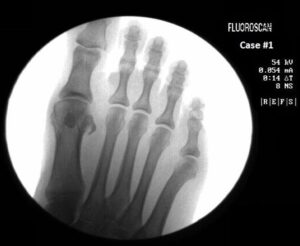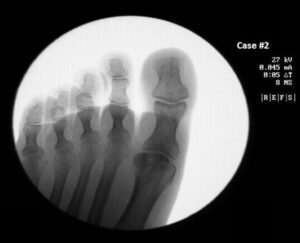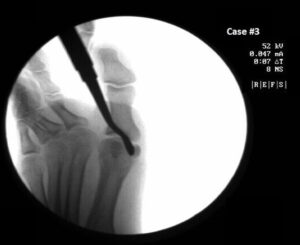Brady M Brooks1, Kristina B Wolff2, Brandon M Brooks2,3*
1Diagnostic Radiology Residency Program, The University of Kentucky College of Medicine, Lexington, Kentucky, USA
2The Dartmouth Institute (TDI), Dartmouth College, Hanover, New Hampshire, USA
3Surgical Service, Wm. Jennings Bryan Dorn VA Medical Center, Columbia, South Carolina, USA
*Correspondence author: Brandon M Brooks, Surgical Service, Wm. Jennings Bryan Dorn VA Medical Center, Columbia, South Carolina, USA;
Email: [email protected]
Published Date: 30-04-2024
Copyright© 2024 by Wolff KB, et al. All rights reserved. This is an open access article distributed under the terms of the Creative Commons Attribution License, which permits unrestricted use, distribution, and reproduction in any medium, provided the original author and source are credited.
Abstract
Background: Female service members tend to have a higher level of foot injuries than males. The United States Army spent $103 million in 2017 on fractures in toes and feet. Fractures of the tibial and fibular sesamoids are a problem that often can be nonspecific, mainly related to pain at the plantar aspect of the first metatarsal head without an obvious traumatic event. Anatomic variation in these sesamoids exist after ossification which results in the possibility of multipartite sesamoids. Of the multipartite sesamoids, bipartite sesamoids are the relatively common and tripartite sesamoids are quite rare. The overall prevalence of bipartite sesamoids is presumed to be between 7 and 30%, with a majority occurring bilaterally.
Methods: We completed a case series on three female active-duty Airmen. All three patients were active with their pain beginning following activity. All three were subsequently misdiagnosed, resulting in at least 6 months of pain prior to diagnosis and treatment.
Results: Plain film radiography and subsequent imaging confirmed the diagnosis of a tibial or fibular sesamoid fracture. Following conservative treatment all three patients made a full recovery as confirmed by imaging and self-reported pain levels and they were able to return to full activity.
Conclusion: Providers should keep a sesamoid fracture in the differential diagnosis when evaluating active female patients with pain in the area around the base of the great toe, especially in women in the military and others that may do higher levels of physical activity compared to the average patient. While the diagnosis of sesamoid fractures can be challenging, it is standard practice to obtain multiple views if using plain film radiography. Magnetic resonance imaging, weightbearing computed tomography and bone scans can be useful confirmatory studies.
Keywords: Air Force; Magnetic Resonance Imaging; Military Medicine; Hallux Sesamoid Fractures
Introduction
Fractures of the tibial and fibular sesamoids are problem that often can be nonspecific, mainly related to pain at the plantar aspect of the first metatarsal head without an obvious traumatic event. These fractures can be easily misdiagnosed due to the wide variety of non-traumatic pathologies can affect the hallux sesamoid complex of the foot, which include degenerative, inflammatory, vascular, infectious and neoplastic conditions [1]. Further, anatomic variation in these sesamoids exist after ossification around age 6 to 7 the possibility of multipartite sesamoids arises from their multiple ossification centers [2,3]. Of the multipartite sesamoids, bipartite sesamoids are the relatively common and tripartite sesamoids are quite rare [4]. The overall prevalence of bipartite sesamoids is presumed to be between 7 and 30% with 80-90% also occurring in contralateral foot [2,5]. These normal anatomic variants have also contributed to misdiagnosis of hallux sesamoid fractures.
The physiological differences between men and women can be associated with foot injuries among people in the United States Military [6-9]. Female service members tend to have a higher level of foot injuries than males [6-8]. The type of injury can vary by level of fitness, occupation, age and rank [7-10]. These injuries are often caused by frequent running, marching and jumping [6,7]. Looking solely at the United States Army, fractures in toes and feet cost over $103 million in 2017, which is 89% of the overall medical costs relating to the lower extremity [6]. It has been shown that the indirect cost of care is significantly higher than direct costs [6]. Service members can be reinjured before they have fully healed [10].
Missed and misdiagnosis of fractures in feet are costly due to cost of care, impact on readiness and health of service members [6,7]. Given that sesamoid fractures are a challenging condition to diagnosis, we report this case series of misdiagnosed sesamoid fractures in women in the United States Air Force that led to unnecessary and prolonged pain for these patients. We aim to better educate providers regarding this condition.
Method and Methods
An extensive review of the literature was done by obtaining published journal articles by utilizing PubMed and OneSearch. Inclusion criteria included terms: great toe, sesamoid bone, stress fracture, fatigue fracture, air force personnel, military, working women.
The patients presented in this case series were active-duty women who were referred to an outpatient podiatry clinic in the Southern United States after undergoing plain film radiograph with their on-base primary care physicians for foot pain. All patients underwent fluoroscopy upon their initial visit at the outpatient podiatry clinic and were diagnosed with a sesamoid fracture – tibial or fibular. All patients underwent subsequent imaging with proper diagnosis which was confirmed by radiology.
Results
Case 1
A 46-year-old woman who presents for right foot pain. She reports that her pain began over 1 year ago. She previously was given injections and Non-Steroidal Anti-Inflammatory Drugs (NSAIDs), which didn’t help her pain. 7/10 throbbing pain today; non-radiating in nature. She states that her pain is worse with walking and running. She denies any specific trauma. Upon, physical examination, pain on palpation of the plantar 1st metatarsal head is noted. Fluoroscopy confirmed a fibular sesamoid fracture (Fig. 1). The fracture was more easily seen on a subsequent, mildly rotated view (Fig. 2). Case 1 represents a straightforward, easily seen sesamoid fracture. Multiple views (Fig. 1,2) enabled this diagnosis.
Case 2
A 29-year-old woman who presents with isolated pain under the left 1st MTP joint region. Present 1 year in duration. This was rendered her unable to run her weekly 20 miles. 7/10 aching pain. She was given NSAIDs which did not alleviate her pain. Her pain is non-radiating in nature. She denies any trauma to the area that she can recall. Upon physical exam, pain is associated with dorsiflexion of the hallux and palpation of the tibial sesamoid region. Fluoroscopy reveals a fracture of the tibial sesamoid (Fig. 3).
Case 3
A 42-year-old woman presents to the office for left great toe pain. Present for over 6 months. It began after a 13-mile run. She reports worsened pain with activity and improved pain with rest. She has tried NSAIDs, which helped a little but the problem persists. She denies any other trauma to the area. 6/10 pain; dull and non-radiating in nature. Upon physical exam, swelling and pain on palpation of the plantar 1st metatarsal head at the level of the sesamoids was noted. Fluoroscopy revealed a possible fracture of the tibial sesamoid (Fig. 4). To further isolate the pain, an instrument was used as a radiographic marker in the area that the patient reported that her pain was worst (Fig. 5). Compared to case 1, case 3’s sesamoid fracture is less straightforward and obvious. Subsequent imaging confirmed the diagnosis of a sesamoid fracture.
All Cases
Following their respective diagnoses of a sesamoid fracture, all patients underwent conservative therapy and subsequently recovered as confirmed by imaging, physical exam and patient-reported pain scores. All patients made a full return to duty, normal activity and reported no pain at their final, twelve month follow up.

Figure 1: Case #1 Fibular sesamoid Fracture: view 1 using fluoroscopy.

Figure 2: Case #1 Fibular sesamoid Fracture: view 2 using fluoroscopy.

Figure 3: Case #2 Tibial Sesamoid Fracture using fluoroscopy.

Figure 4: Case #3 Tibial Sesamoid Fracture: view 1 using fluoroscopy.

Figure 5: Case #3 Tibial Sesamoid Fracture: view 2 using fluoroscopy with use of an instrument to pinpoint the pain in lieu of a radiographic marker.
Discussion
In this case series, three female members of the United States Air Force suffered sesamoid fractures that were misdiagnosed. Providers should keep sesamoid fracture in the differential when evaluating active females, especially women in the United States Military, whom present with pain in the area around the base of the first toe [11]. In these three patient case series, all three cases had undergone imaging prior to referral and were told that they didn’t have any fractures. All three cases suffered with pain for at least 6 months before receiving the accurate diagnosis and care. All three women were very active and subject to these types of injuries. With sesamoid fractures, there isn’t always a specific incident, such as a motor vehicle accident that we may associate with trauma [2]. Sesamoid fractures are an over-use or stress injury. Female sex, low bone density, nutritional disorders, long-distance running, training changes, inadequate shoes and an inappropriate short recovery time is known to increase the risk of a stress injury, including a sesamoid fracture; women in the military may have several of these risks [12]. The equipment that women use in the armed services is primarily designed for males [13-15]. This has come to light nationally as women veterans and active-duty service members’ years of advocacy to create uniforms, boots and most recently body armor, is slowly being acknowledged and adopted in each of the services [13-15]. In 2018 the Defense Advisory Committee on Women in the Services (DACOWITS) produced a study that emphasized the important of improving clothing and body armor for women yet failed to address the essential need to improve footwear [16].
Diagnostic Techniques and Tips
Given that 80-90% of bipartite sesamoids are bilateral taking an image of the contralateral limb may be useful via plain film radiography [2,3]. Bipartite sesamoids have regular edges and typically appear larger than the neighboring sesamoid; a bipartite tibial sesamoid will be larger than a fibular sesamoid and vice versa [2]. Another key insight is check for hallux valgus for the bipartite tibial sesamoids in particular [17]. Patients with hallux valgus are more likely to have bipartite tibial sesamoids compared to patients without hallux valgus [17]. Bone scans, semi-weight bearing Computed Tomography (CT) and Magnetic Resonance Imaging (MRI) scans can be helpful in differentiation if plain films are inconclusive [1]. Providers need to inform radiologists of their concerns if ordering confirmatory studies; if you don’t have access to the correct imaging equipment, it can easy to miss a sesamoid fracture. It is also produced to rule out other inflammatory pathology given the location of the sesamoids relative to the first metatarsophalangeal joint.
Advanced imaging modalities, such as CT and MRI can be used if there is difficulty in making a definitive diagnosis. Given that access to appropriate imaging can be a problem and since not all patients or providers readily have access to CT, one promising new innovation is the mobile weightbearing CT (Fig. 6) [18]. Mobile weightbearing CT imaging brings a variety of benefits and is becoming more economically viable, which in turn has opened up access to care to many [18].
Conservative Care (The Treatment Option of Choice)
Initial attempts at management of sesamoid fracture include a period of non-weight bearing or limited weight bearing, orthotics or padding for offloading [2]. The hallux may be taped in a plantarflexed or neutral position in order to avoid excessive dorsiflexion, CAM boots and casting may also be used in order to limit motion and facilitate healing [2]. Clinical evidence suggests that most sesamoid fractures heal without the need for surgery thus, conservative measures should be used first [2]. NSAIDs may also help to provide relief [1,2,4,11,19,20].
Surgical Care (The Secondary Treatment Option)
Given that many patients respond well to conservative therapy, surgical care remains a lesser chosen and rightfully secondary option. Non-unions may be treated with percutaneous fixation, open fixation or autogenous bone grafting [20]. In one study (n =9), all patients that underwent percutaneous screw fixation for their sesamoid fractures reported substantial pain relief at 3 months post-op [21]. Surgical treatment may include partial or complete resection of the fractured sesamoid [2,20]. However, it is prudent to avoid the excision of a sesamoid, especially both sesamoids, whenever possible [20].

Figure 6: A new innovation, the mobile weightbearing CT truck improves access to advanced imaging to rural areas.
Limitations
Limitations of the study design include the small sample size. Future studies would benefit from expanding patient age and branch of service.
Conclusion
Providers should keep a sesamoid fracture in the differential diagnosis when evaluating active female patients with pain in the area around the base of the great toe, especially in women in the military and others that may do higher levels of physical activity compared to the average patient. While the diagnosis of sesamoid fractures can be challenging, it is standard practice to obtain multiple views if using plain film radiography. In a female patient with positive plantar first metatarsal head pain, in the absence of a contralateral bipartite sesamoid and hallux valgus (for the tibial sesamoid), there must be a high degree of suspicion for a sesamoid fracture. Plain film radiography can diagnose sesamoid fractures; MRI, semi-weight bearing CT and Bone Scans can be useful confirmatory studies. If ordering confirmatory studies, providers should inform radiologists of their suspicion for a sesamoid fracture. Overall, most patients, such as the cases presented in this case series, do well with conservative treatment and are able to return to full activity.
Conflict of Interests
The author declares that there is no conflict of interest for this paper.
References
- Lombard C, Gillet R, Rauch A, Germain E, Dodin G, Blum A, et al. Hallux sesamoid complex imaging: a practical diagnostic approach. Skeletal Radiol. 2020;49:1889-901.
- Sims AL, Kurup HV. Painful sesamoid of the great toe. World J Orthop. 2014;5:146-50.
- Yammine K. The sesamoids of the feet in humans: a systematic review and meta-analysis. Anat Sci Int. 2015;90:144-60.
- Lee SYS, Tan TJ, Yan YY. Fracture of a bipartite medial hallux sesamoid masquerading as a tripartite variant: a case report and review of the literature. J Foot Ankle Surg. 2019;58:980-3.
- Munuera PV, Domínguez G, Reina M, Trujillo P. Bipartite hallucal sesamoid bones: relationship with hallux valgus and metatarsal index. Skeletal Radiol. 2007;36:1043-50.
- Forrest LJ, Jones BH, Barnes SR, Hauschild VD, Schuh-Renner A, Grier TL, et al. The cost of lower extremity fractures among active duty. US Army Soldiers. 2017. MSMR. 2021;28:6-12.
- Knapik JJ, Brosch LC, Venuto M, Swedler DI, Bullock SH, Gaines LS, et al. Effect on injuries of assigning shoes based on foot shape in air force basic training. Am J Prev Med. 2010;38.
- Wallace RF, Wahi MM, Hill OT, Kay AB. Rates of ankle and foot injuries in active-duty US Army Soldiers. 2000-2006. Mil Med. 2011;176:283-90.
- Rappole C, Grier T, Anderson MK, Hauschild V, Jones BH. Associations of age, aerobic fitness and body mass index with injury in an operational Army brigade. J Sci Med Sport. 2017;20(Suppl 4):S45-50.
- Rhon DI, Greenlee TA, Cook CE, Westrick RB, Umlauf JA, Fraser JJ. Fractures and chronic recurrence are commonly associated with ankle sprains: a 5-year population-level cohort of patients seen in the US Military Health System. Int J Sports Phys Ther. 2021;16.
- Stein CJ, Sugimoto D, Slick NR, Lanois CJ, Dahlberg BW, Zwicker RL, et al. Hallux sesamoid fractures in young athletes. Phys Sportsmed. 2019;47:441-7.
- Goolsby MA, Boniquit N. Bone health in athletes. Sports Health. 2017;9:108-17.
- Female soldiers face higher risk of training injuries, study finds – reporting Texas ★ Reporting Texas. [Last accessed on: April 23, 2024]
https://reportingtexas.com/female-soldiers-face-higher-risk-of-training-injuries-study-finds/
- Barbeau P, Michaud A, Hamel C, Rice D, Skidmore B, Hutton B, et al. Musculoskeletal Injuries Among Females in the Military: A Scoping Review. Mil Med. 2021;186:E903-31.
- US military pressed to design special line of combat boots just for women – Washington Times [Last accessed on: April 23, 2024]
https://www.washingtontimes.com/news/2015/may/14/military-pressed-to-design-line-of-women-friendly-/
- Defense Advisory Committee On Women In The Services (DACOWITS) Quarterly Meeting Minutes, Arlington, DACOWITS. 2018. [Last accessed on: April 23, 2024]
- Weil LS, Hill M. Bipartite tibial sesamoid and hallux abducto valgus deformity: a previously unreported correlation. J Foot Surg. 1992;31:104-11.
- Baer J. Webinar highlights: designing a mobile imaging suite to serve multi-location practices. 2020. [Last accessed on: April 23, 2024].
- Sun T, Zhao H, Wang L, Wu W. Partite hallux sesamoid bones: Relationship with sesamoid bones at other metatarsophalangeal joints. Anatomical Record. 2018;301:34-8.
- Richardson EG. Hallucal sesamoid pain: causes and surgical treatment. J Am Acad Orthop Surg. 1999;7:270-8.
- Blundell CM, Nicholson P, Blackney MW. Percutaneous screw fixation for fractures of the sesamoid bones of the hallux. J Bone Joint Surg Br. 2002;84:1138-41.
Article Type
Case Report
Publication History
Accepted Date: 31-03-2024
Accepted Date: 23-04-2024
Published Date: 30-04-2024
Copyright© 2024 by Brooks BM, et al. All rights reserved. This is an open access article distributed under the terms of the Creative Commons Attribution License, which permits unrestricted use, distribution, and reproduction in any medium, provided the original author and source are credited.
Citation: Brooks BM, et al. Misdiagnosis or Missed Diagnosis – Hallux Sesamoid Fractures among Active-Duty Females in the United States Air Force: A Case Series. J Ortho Sci Res. 2024;5(1):1-8.

Figure 1: Case #1 Fibular sesamoid Fracture: view 1 using fluoroscopy.

Figure 2: Case #1 Fibular sesamoid Fracture: view 2 using fluoroscopy.

Figure 3: Case #2 Tibial Sesamoid Fracture using fluoroscopy.

Figure 4: Case #3 Tibial Sesamoid Fracture: view 1 using fluoroscopy.

Figure 5: Case #3 Tibial Sesamoid Fracture: view 2 using fluoroscopy with use of an instrument to pinpoint the pain in lieu of a radiographic marker.

Figure 6: A new innovation, the mobile weightbearing CT truck improves access to advanced imaging to rural areas.


